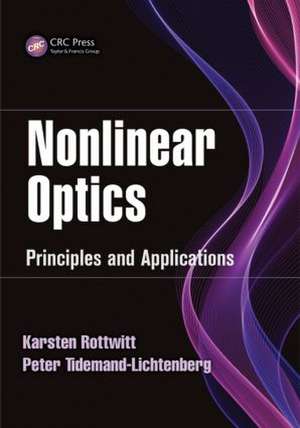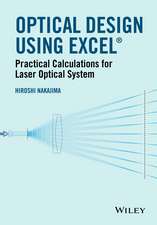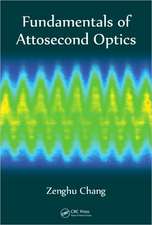Nonlinear Optics: Principles and Applications: Optical Sciences and Applications of Light
Autor Karsten Rottwitt, Peter Tidemand-Lichtenbergen Limba Engleză Hardback – 11 dec 2014
As nonlinear optics further develops as a field of research in electromagnetic wave propagation, its state-of-the-art technologies will continue to strongly impact real-world applications in a variety of fields useful to the practicing scientist and engineer. From basic principles to examples of applications, Nonlinear Optics: Principles and Applications effectively bridges physics and mathematics with relevant applied material for real-world use. The book progresses naturally from fundamental aspects to illustrative examples, and presents a strong theoretical foundation that equips the reader with enough knowledge to recognize, understand, and evaluate nonlinear optical phenomena.
Structured so that the first five chapters are dedicated to the description of the fundamental formalism of nonlinear optics, and the last five chapters are devoted to a description of practical devices based on nonlinear phenomena, it describes nonlinear wave propagation in bulk and in waveguiding structures, and includes specific examples of applied nonlinear wave propagation through crystals, optical waveguides, and optical fibers. Providing a theoretical description of nonlinear interaction between light and matter, this text focuses on the physical understanding of nonlinear optics, and explores optical material response functions in the time and frequency domain.
This pivotal work contains ten chapters and the main applications include:
- Optical signal processing: parametric amplification, modulators
- Transmission of optical signals: optical solitons, cross-phase modulation, four-wave mixing, phase conjugation, Raman scattering
- Sensing: temperature sensors, spectroscopy, and imaging
- Lasers: pulse compression and generation of super continuum
Preț: 766.88 lei
Preț vechi: 842.72 lei
-9% Nou
Puncte Express: 1150
Preț estimativ în valută:
146.77€ • 152.82$ • 124.03£
146.77€ • 152.82$ • 124.03£
Carte tipărită la comandă
Livrare economică 10-24 martie
Preluare comenzi: 021 569.72.76
Specificații
ISBN-13: 9781466565821
ISBN-10: 1466565829
Pagini: 349
Ilustrații: 81 black & white illustrations, 11 black & white tables
Dimensiuni: 178 x 254 x 23 mm
Greutate: 0.81 kg
Ediția:1
Editura: CRC Press
Colecția CRC Press
Seria Optical Sciences and Applications of Light
ISBN-10: 1466565829
Pagini: 349
Ilustrații: 81 black & white illustrations, 11 black & white tables
Dimensiuni: 178 x 254 x 23 mm
Greutate: 0.81 kg
Ediția:1
Editura: CRC Press
Colecția CRC Press
Seria Optical Sciences and Applications of Light
Cuprins
Introduction. Time-domain material response. Material response in the frequency domain, susceptibility tensors. Symmetries in nonlinear optics. The nonlinear wave equation. Second-order nonlinear effects. Raman scattering. Brillouin Scattering. Optical Kerr effect. Four wave mixing.
Recenzii
"This book is a new reference for nonlinear optics professionals as well as graduate students specializing in nonlinear optics. It provides, in a comprehensive and organized manner, the essential mathematical formalisms and physical descriptions for understanding basic principles of nonlinear optics. The authors cover principles of linear optics and material response in the time and frequency domain, symmetries in nonlinear optics with special emphasis on second- and third-order nonlinear materials, and the nonlinear wave equation in waveguides. The first five chapters describe the fundamental formalism of nonlinear optics, whereas the last five chapters of the book discuss practical applications based on nonlinear phenomena. This publication has been supplemented with a few appendices, as well as a website with theoretical/numerical exercises, lecture slides, etc."
--Reva Garg, Institute of Physics, University of Brazil, from Optics & Photonics News, November 23, 2015
"This book provides the essential mathematical formalisms and physical descriptions necessary for the understanding of underlying principles of nonlinear optics, from nonlinear wave propagation in dielectric media to crystal optics, nonlinear optical processes, and devices. The book is suitable for a broad readership, from newcomers to nonlinear optics to those more intimately familiar with the topic who wish to further strengthen their knowledge and their formal mathematical foundations of nonlinear optics. The book uses classical mathematical formulation at a level suitable for students in the latter stages of their undergraduate Bachelors' studies who wish to become familiar with the subject area, or for more advanced graduate students pursuing Masters' degrees or in their early Ph.D programs preparing to embark on a research career in nonlinear optics. It is also suitable for researchers already active in the field of nonlinear optics who wish to strengthen their mathematical foundation of the subject. The book is well written, logically organized, and easy to follow, which helps the reader gain an in-depth understanding of nonlinear optical phenomena."
--Prof. Majid Ebrahim-Zadeh, ICFO-The Institute of Photonic Sciences, Barcelona, Spain
"This textbook is a welcome addition, as it provides a comprehensive and balanced treatment of nonlinear optics, covering both the underlying physics as well as important applications. Lucid explanations with contemporary relevance make it useful for science and engineering students, teachers, and researchers to get a thorough understanding of the subject. The authors provide a detailed exposition of the fundamental aspects of nonlinear optics that includes principles of linear optics and material response in the time and frequency domain, symmetries in nonlinear optics with special emphasis on second and third-order nonlinear materials, and the nonlinear wave equation in waveguides. The origin, modeling, and consequences of the important second- and third-order nonlinear optical effects with applications in frequency conversion, electro optic effect in crystals, Raman and Brillouin scattering in optical fibres, optical Kerr effect, and four wave mixing in parametric devices, has been presented effectively. The text has been well supplemented with illustrations and appendices to enhance the presentation."
--Prof. Sukhdev Roy, Dayalbagh Educational Institute, India
--Reva Garg, Institute of Physics, University of Brazil, from Optics & Photonics News, November 23, 2015
"This book provides the essential mathematical formalisms and physical descriptions necessary for the understanding of underlying principles of nonlinear optics, from nonlinear wave propagation in dielectric media to crystal optics, nonlinear optical processes, and devices. The book is suitable for a broad readership, from newcomers to nonlinear optics to those more intimately familiar with the topic who wish to further strengthen their knowledge and their formal mathematical foundations of nonlinear optics. The book uses classical mathematical formulation at a level suitable for students in the latter stages of their undergraduate Bachelors' studies who wish to become familiar with the subject area, or for more advanced graduate students pursuing Masters' degrees or in their early Ph.D programs preparing to embark on a research career in nonlinear optics. It is also suitable for researchers already active in the field of nonlinear optics who wish to strengthen their mathematical foundation of the subject. The book is well written, logically organized, and easy to follow, which helps the reader gain an in-depth understanding of nonlinear optical phenomena."
--Prof. Majid Ebrahim-Zadeh, ICFO-The Institute of Photonic Sciences, Barcelona, Spain
"This textbook is a welcome addition, as it provides a comprehensive and balanced treatment of nonlinear optics, covering both the underlying physics as well as important applications. Lucid explanations with contemporary relevance make it useful for science and engineering students, teachers, and researchers to get a thorough understanding of the subject. The authors provide a detailed exposition of the fundamental aspects of nonlinear optics that includes principles of linear optics and material response in the time and frequency domain, symmetries in nonlinear optics with special emphasis on second and third-order nonlinear materials, and the nonlinear wave equation in waveguides. The origin, modeling, and consequences of the important second- and third-order nonlinear optical effects with applications in frequency conversion, electro optic effect in crystals, Raman and Brillouin scattering in optical fibres, optical Kerr effect, and four wave mixing in parametric devices, has been presented effectively. The text has been well supplemented with illustrations and appendices to enhance the presentation."
--Prof. Sukhdev Roy, Dayalbagh Educational Institute, India
Notă biografică
Karsten Rottwitt received his PhD in 1993 from the Technical University of Denmark (DTU) within propagation of solitons through optical fiber amplifiers. His Post doc was in collaboration with the femtosecond optics group, Imperial College London. From 1995 to 2000 Rottwitt continued at Bell Labs, AT&T and Lucent Technologies, New Jersey, USA. His research was directed toward Raman scattering in optical fibers. In 2000 Rottwitt moved back to Denmark where he is now at the department for photonics engineering, DTU. His research is concentrated on optical fiber nonlinearities including interactions among higher order modes, with applications within bio-photonics, sensing and communication.
Peter Tidemand-Lichtenberg has been working with novel light sources and detection systems for 20 years. He completed his PhD in 1996 from the Technical University of Denmark. After receiving his PhD, he spent six years in small start-up companies developing light sources for various industrial applications. In 2002 he returned to DTU to develop compact coherent light sources in the UV and visible spectral region. He has mainly focused on extending the spectral coverage toward the mid-IR region, and developing efficient light sources and low noise detection systems in the 2-12 µm range based on frequency mixing for the past five years.
Peter Tidemand-Lichtenberg has been working with novel light sources and detection systems for 20 years. He completed his PhD in 1996 from the Technical University of Denmark. After receiving his PhD, he spent six years in small start-up companies developing light sources for various industrial applications. In 2002 he returned to DTU to develop compact coherent light sources in the UV and visible spectral region. He has mainly focused on extending the spectral coverage toward the mid-IR region, and developing efficient light sources and low noise detection systems in the 2-12 µm range based on frequency mixing for the past five years.
Descriere
This book describes the fundamental aspects of nonlinear optics from basic principles to applications. Starting from the polarization induced by an electric field in a material, it relates the induced polarization to the propagating fields. It describes the properties of the induced polarization through a material response expressed both in the time and frequency domains leading to the nonlinear wave equation. The second part of the book focuses on applications of nonlinear interaction between light and matter, and considers nonlinearities in crystals and optical fibers.





























